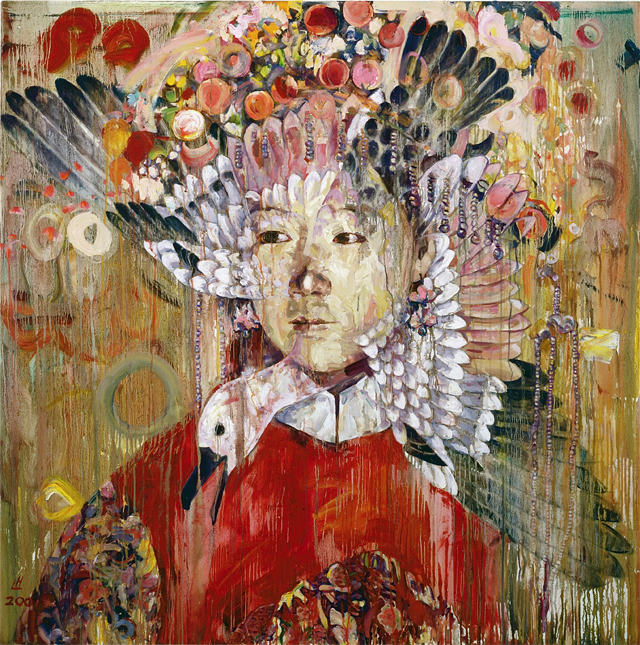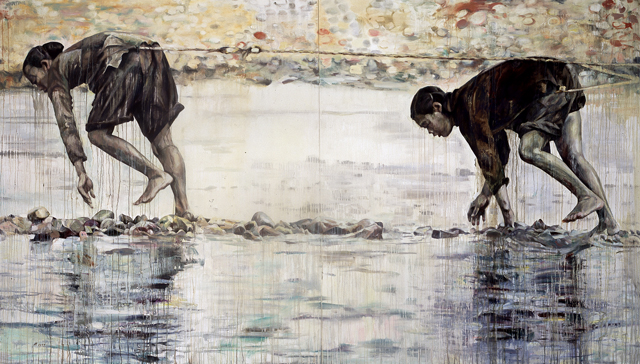Oakland Museum of California
Oakland, CA
March 16 – June 30, 2014
With drips and washes, color, photography and shaped canvases, shelves and artifacts, the art of Hung Liu in her spring exhibit, Summoning Ghosts, at the Oakland Museum of California, feeds the eyes. What a joy it was to be present with the China-born artist’s energy reflected in the retrospective, which will be traveling nationally. This exhibit is a coming home of her work spanning from the 1960s in China to the present in America. Presented by Senior Curator of Art René de Guzman, Summoning Ghosts invites viewers into the world of memory and history and the power of art.
Hung Liu was born in Changchun, Manchuria, in 1948, the year Mao Zedong drove the Nationalist forces to the island of Taiwan. During the Cultural Revolution, Liu was sent to the countryside to labor in the fields for four years. After the Cultural Revolution, she was admitted to Beijing Teachers College and later completed the Central Academy of Fine Art with a degree in Mural Painting. Seeking artistic freedom from the restrictiveness of Socialist Realism in which she was trained, Liu came to the United States in 1984. A tenured professor in the Department of Art at Mills College in Oakland, Liu’s art, from small to huge canvases, crowns her dynamism as a woman of power and strength.
Special passions. While Liu has received accolades and recognition as an artist, what speaks to me is her feminist thrust and compassion for Chinese workers, women and children. Of particular significance in Summoning Ghosts, is a painting of prostitutes sitting on rocks, outdoors, facing you, the viewer, as if to say, “we are women, after all, we are human. Look at us, understand what we do and why.”
Another painting, titled Heroine Gu Yanxiu, 2012, depicts over a dozen women laboring over the land of hard rock scrabble, a scene of reconstruction of the Chinese countryside. This painting of women using their bodies to rebuild a war-torn country affirming female decisive humanity contrasts sharply with the artists Strange Fruit: Comfort Women, 2001, depicting a group of Korean “comfort” women who were forced to sexually serve Japanese soldiers in World War II.
Particularly awakening in Liu’s art is Hua Gang (Flower Ridge), 2005, portraying eight Chinese slave laborers, their bones protruding from their bodies, captives of Japan, at the end of World War II. Pink flowers dot the ground, in back of the men against a shack. Blossoms even decorate their bodies. This forces me to gasp, to view it again and again. Then there’s a photograph that Liu transformed into a painting that refreshes. It’s entitled Band of Brothers, 2011. The colors, orange and yellow, blaze on shorts worn by boys. They are alive, bare-chested, with wide grins of joy, taking a break from hours of hard labor.
In Sisterhoods, 2003, three girls walk arm-in-arm, in 1950s Beijing, a year after the establishment of the revolution, I cannot but feel the comradeship of females walking tall and proud, whether related by blood or not.
Liu’s art explodes and implodes; they are fireworks bursting against a night sky. “Finding old photographs made me very excited,” Liu says, many of which have inspired this brave soul to gift our world with her vibrant eye, her working fingers, her deep breaths of how art illuminates history which to her is a verb, not a noun.
Art, history and memory. Many of Liu’s paintings emanate from black-and-white photographs. The colors come from memory, guided by her all-seeing eye. This is a woman who breathes history, utilizing drips and washes, not as camouflage but as rain or tears inviting you to ponder, to think. For example, in September, 2001, Liu paints a young girl, appearing apprehensive. The girl’s face is framed by an open-beaked bird encircling her neck, fused with fruits and flowers. Liu turned to symbols of nature to process the enormity of 9/11.
Just as she does with her illuminating images of mothers and daughters, prostitutes, male laborers and a series of small photos, My Secret Freedom, created secretly during government persecution. In Peeking Opera, rendered from the famous photo of a young man standing in front of tanks in the 1989 Tiananmen Square protests, Hung Liu plays with the word “Peking” and paints of freedom for the dispossessed, the poor, working people, the individual.
“A world without ghosts,” Hung Liu tells us, “is like a person without a shadow, an idealized yet impossible fantasy. The ghosts symbolize our rich, complicated, most times rather painful history and memory. Only after embracing the ghosts inside and outside us, we then have a better understanding of ourselves, our time, and our mission.” Embracing the art of Hung Liu is to act, for she summons the ghosts for us.
— FSP October 2013 review of Summoning Ghosts – The Art of Painter Hung Liu by Nellie Wong,

Hung Liu
September, 2001
Oil on canvas, 66 × 66 in. (167.6 × 167.6 cm)
Collection of Driek and Michael Zirinsky
